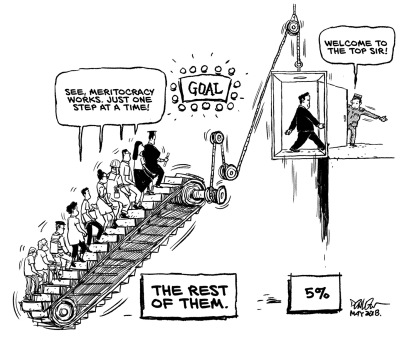A World Where the Greater Good Predominates Over Profits
The Visionary Notion
What if the primary driving force behind commercial and economic endeavors wasn’t the pursuit of profits, but rather benefiting society, the species, Gaia, and the planet? A visionary notion, to be sure, that seems to defy conventional capitalist wisdom. Nevertheless, if we allow our imaginations to roam freely and look back at periods in history where ethical business practices held sway, we can depict a world truly transformed by this paradigm shift.
Profit Motives vs. Ethics and Humanity
Throughout most of human history, the profit motive has reigned supreme in the business realm. However, there have been notable exceptions driven by religious teachings, philosophical movements, and social ideals that prioritised ethical conduct over mere grubby accumulation of more and more wealth. The Quakers, for instance, were renowned for their commitment to honest dealings and consideration of employee welfare, exemplified by the socially-conscious British chocolate makers like Cadbury. The 19th century cooperative movement aimed to create enterprises that equitably shared profits with worker-owners and the local community.
The Beauty of Ethical Business
Would we call businesses truly putting the greater good before profits “beautiful”? At first, such a description may seem like an odd coupling of aesthetics with commerce. But perhaps there is an inherent beauty to enterprises that create sustainable value for society while exhibiting ethical conduct.
Just as we find natural wonders, artistic works, or selfless acts emotionally moving due to their harmony with higher ideals of truth, goodness, and transcendence of ego, so could businesses centered on benefiting all stakeholders embody a different kind of beauty. One not necessarily based on physical appearance, but on being skillfully crafted exemplars of how our economic activities can align with ethical, aesthetic, environmental and humanitarian principles.
This beauty manifests through their products, services, and operations, harmonising with the world rather than undermining it through greed, despoilment, or exploitation. Beautiful businesses are sustainable and circular by design, creating goods to be celebrated and cherished rather than cynically designed for disposability.They invest in creating opportunity and dignity for workers and communities rather than grinding them underfoot for profit margins.
Where today’s shareholder-driven corporations often exemplify grotesque machineries of extraction, ethical enterprises putting people and planet over money could be sublime new exemplars of applied aesthetics – aspiring toward perfection not through profit metrics, but through positively impacting all they engage with. Their beauty would shine through in becoming tightly interwoven threads in an interdependent tapestry, creating joyful, resilient and regenerative systems that elevate our shared potential.
While the traditional business vernacular focuses on the uglyness of lucrative processes, revenue growth, and reputational brand value, a world where ethical enterprises reign would celebrate hallmarks of perfected form: generative models that produce societal good, environmental integrity, attending to folks’ needs, and uplifting the human spirit. Perhaps then, we could appreciate the highest “good companies” not just pragmatically, but aesthetically – as living artworks of conscious, ethical organisation.
A World Oriented Toward the Greater Good
In such a world oriented toward the greater good, companies measure success not just by financial returns, but by positive impacts. Ethical practices like those espoused by certain faith traditions and thinkers are the norm across these industries. Sustainability is prized over short-term gain, with environmental stewardship prioritised over resource exploitation. We’ve seen glimpses of this in recent decades through the rise of corporate social responsibility (CSR), socially conscious investing, and the emergence of benefit corporations legally bound to creating public benefit, not just profits. But such examples have remained the exception rather than the rule in a profit-driven system.
The Global Ethos of the Greater Good
Imagine if this ethos becomes the core operating principle globally. Rather than lobbying for narrow interests, these businesses advocate for the common good. Tax avoidance schemes would be abandoned in a system where contributing one’s fair share is the ethical baseline. Worker rights and equity are vigorously protected, not eroded in pursuit of higher margins. On an individual level, cutthroat workplace could gives way to healthier cooperation, and integration with our personal and community values and family lives. Ethical conduct is rewarded over pure profit-generation at any cost. Kudos is not derived from endless growth metrics, but to positive impacts created for all the Folks That Matter™.
A Sustainable Economic Model
Of course, enterprises still need to generate income to remain viable and reinvest in their social missions. But growth is pursued by creating genuine value for society rather than extracting it. Sustainable, circular economic models replace those premised on endless consumption and planned obsolescence.
A Radical Yet Possible Vision
Such a world may seem naively idealistic to modern sensibilities, conditioned to accept profit as the prime directive. But is it any more far-fetched than an entrenched global system that relentlessly exploits people and finite resources in pursuit of perpetual economic expansion on a finite planet? By orienting business toward the greater good, as past ethical movements have done, we might create an economy that better serves humanity. This may read as a utopian ideal today, but it has been a reality at various points throughout our history. A world where businesses prioritise society over self-interest may not be inevitable, but it is possible if we dare to imagine and build it together.
Do you have even the briefest five minutes to contemplate how things might be different?
Further Reading
Ackoff, R. L. (2011). The aesthetics of work. In Skip Walter’s blog post retrieved from https://skipwalter.net/2011/12/25/russ-ackoff-the-aesthetics-of-work/




